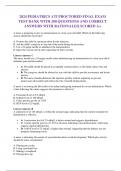Exam (elaborations)
2024 PEDIATRICS ATI PROCTORED FINAL EXAM TEST BANK WITH 200 QUESTIONS AND CORRECT ANSWERS WITH RATIONALES| SCORED A+
- Course
- Institution
2024 PEDIATRICS ATI PROCTORED FINAL EXAM TEST BANK WITH 200 QUESTIONS AND CORRECT ANSWERS WITH RATIONALES| SCORED A+ The nurse is preparing to administer an immunization to a four-year-old child. Which of the following actions should the nurse plan to take? A- Place the child in a prone positi...
[Show more]



